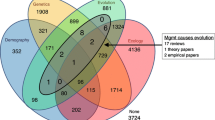Abstract
The human health risk assessment (HRA) paradigm is being used as a basis for developing ecological risk assessment (ERA). The modification of the HRA paradigm to ERA will be most useful in an ecotoxicological sense, to assess the effect of hazards to single indicator species and populations, rather than to ecosystems. However, even for single species and population assessments, there are major differences in HRA and ERA. One such difference derives from the HRA tenet that human impairment at any age is important, and that each individual is important. For ERA, individuals are less important, and it is the population and its survival and interactions that are of concern. One exception is in the case of endangered species where every individual is critical because of its potential impact on survival and genetic diversity of the species. We suggest that ERA must take into account the relative reproductive value of the potentially impacted individuals in assessing hazards. This will involve adding additional steps to evaluate the value of the individual to current population levels, assessing reproductive value, and assessing recovery potential. Although ecologists recognize the importance of these factors, we suggest that they should be integral parts of ecological risk assessment.
Similar content being viewed by others
References
Bascietto, J., Hinckley, D., Plafkin, J. and Simak, M.: 1990, ‘Ecotoxicology and Ecological Risk Assessment’, Environmental Science Technol. 24, 10–15.
Beddington, J.R.: 1984, ‘The Response of Multispecies Systems to Perturbation, in R.M. May (Ed.), Exploitation of Marine Communities, C. Dohlem Konferenzen, Springer, Berlin.
Bordeau, P., Somers, E., Richardson, G.M. and Hickman, J.R. (Eds.): 1990, Short-Term Toxicity Tests for Non-Genotoxic Effects, J. Wiley and Sons, Chichester, England.
Butler, G.C.: 1978, Principles of Ecotoxicology, J. Wiley and Sons, Chichester, England.
Burger, J. and Gochfeld, M.: 1992, ‘Temporal Consequences for Ecological Risk Assessment’, Arch. Environ. Cont. Toxicol. 23, 484–488.
Crouse, D.T., Crowden, L.B. and Carwell, H.: 1987, ‘A Stage-Based Population Model for Loggerhead Sea Turtles and Implication for Conservation’, Ecology 68, 1412–1423.
Cairns, J.: 1990, ‘The Geneses of Biomonitoring in Aquatic Ecosystems’, Environ. Professional 12, 169–176.
Fisher, R.A.: 1958, The Genetic Theory of Natural Selection, Dover, New York.
Foose, T.J. and Ballon, J.D.: 1988, ‘Population Management: Theory and Practice’, Int. Zool. Yearbook 27, 26–41.
Graham, R.L., Hunsaker, C.T., O'Neill, R.V. and Jackson, B.L.: 1991, ‘Ecological Risk Assessment at the Regional Scale’, Ecol. Appl. 1, 196–206.
Harris, R.B. and Allendorf, F.W.: 1989, ‘Genetically Effective Population Size of Large Mammals: An Assessment of Estimators’, Cons. Biol. 3, 181–196.
Huggett, R.J., Unger, M.A., Valkirs, A.O. and Seligman, P.F.: 1992, ‘The Marine Biocide Tributyltin’, Environ. Sci. Technol. 26, 232–237.
Hunt, G.L. Jr. and Hunt, W.: 1977, ‘Female-Female Pairing in Western Gulls (Larus occidentalis) in Southern California’, Science 196, 1466–1467.
Hutchins, M. and Wiese, R.W.: 1991, ‘Beyond Genetic and Demographic Management: The Future of the Species Survival Plan and Related AAZPA Conservation Efforts’, Zoo. Biology 10, 185–292.
Lack, D.: 1968, Ecological Adaptations for Breeding in Birds, Methuen, London, England.
Mertz, D.B.: 1970, ‘Notes on Methods Used in Life History Studies’, pp. 4–17 in Readings in Ecology and Ecological Genetics, J.H. Connell, D.B. Mertz and W.W. Murdock (Eds.), Harper and Row, New York.
National Research Council: 1981, Testing for Effects of Chemicals on Ecosystems, National Academy Press, Washington, D.C.
National Research Council: 1983, Risk Assessment in the Federal Government. Managing the Process, National Academy Press, Washington, D.C.
National Research Council: 1986, Ecological Knowledge and Environmental Problem-Solving, National Academy Press, Washington, D.C.
National Research Council: 1990, Decline of the Sea Turtles, National Academy Press, Washington, D.C.
NRC: 1993, Issues in Risk Assessment, National Academy Press, Washington, D.C.
Sheehan, P.J., Miller, D.R., Butler, G.C. and Bourdeau, P. (Eds.): 1984, Effects of Pollutants at the Ecosystem Level, Wiley and Sons, Chichester, England.
Siqurdson, H. and Carey, S.: 1988, ‘The Far Reach of Tambora’, Natural History 6, 66–72.
Soule, M.E.: 1980, ‘Thresholds for Survival in Maintaining Fitness and Evolutionary Potential’, pp. 151–169 in M.E. Soule and B.A. Wilcox (Eds.), Conservation Biology, Sinauer Assoc. Sutherland, Massachusetts.
Wright, S.: 1969, Evolution and the Genetics of Populations. Vol. 2. The Theory of Gene Frequencies, Univ. of Chicago Press, Chicago, Illinois.
Author information
Authors and Affiliations
Rights and permissions
About this article
Cite this article
Gochfeld, M., Burger, J. Evolutionary consequences for ecological risk assessment and management. Environ Monit Assess 28, 161–168 (1993). https://doi.org/10.1007/BF00547034
Received:
Revised:
Issue Date:
DOI: https://doi.org/10.1007/BF00547034




